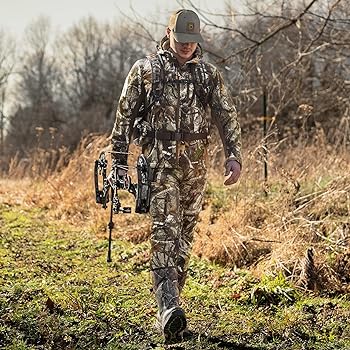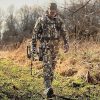Waterproof Hunting Jackets: The Ultimate Guide to Staying Dry and Comfortable in the Field

Introduction
In the world of hunting, facing the elements is part of the challenge. Whether it’s rain, snow, or heavy winds, a hunter’s ability to stay dry and comfortable can significantly impact the overall experience and success of the hunt. This is where waterproof hunting jackets come into play. These jackets are designed not only to provide protection from the weather but also to enhance a hunter’s performance and enjoyment. In this extensive guide, we’ll explore everything you need to know about waterproof hunting jackets, from their features and materials to the top brands and tips for choosing the perfect one.
The Importance of a Waterproof Hunting Jacket
Protection from the Elements
A waterproof hunting jacket is essential for protecting hunters from the unpredictable and often harsh outdoor conditions. Being wet and cold can quickly lead to discomfort, hypothermia, and a decrease in focus and performance. A high-quality waterproof jacket acts as a barrier, keeping rain and snow at bay while maintaining body warmth.
Enhanced Performance
Staying dry is crucial for maintaining peak performance. Wet clothing can weigh you down and restrict movement, making it difficult to react quickly and accurately. Waterproof hunting jackets are designed to be lightweight and flexible, allowing hunters to move freely and quietly.
Prolonged Hunting Sessions
A good waterproof hunting jacket enables hunters to stay in the field longer, even in adverse weather conditions. This increases the chances of a successful hunt and allows for a more enjoyable experience overall.
Key Features of Waterproof Hunting Jackets
When selecting a waterproof hunting jacket, several key features should be considered to ensure it meets your needs and provides maximum protection and comfort.
Waterproof Membrane
The core feature of any waterproof jacket is its waterproof membrane. This layer prevents water from penetrating the fabric while allowing moisture vapor (sweat) to escape. Common waterproof membranes include Gore-Tex, eVent, and proprietary technologies developed by various outdoor brands. These membranes are often laminated or bonded to the jacket’s outer fabric.
Breathability
While keeping water out, a good hunting jacket should also allow for breathability. Breathable fabrics prevent the buildup of sweat inside the jacket, keeping you dry and comfortable. Look for jackets with high breathability ratings to ensure moisture can escape efficiently.
Seam Sealing
To ensure complete waterproofing, the jacket’s seams should be sealed or taped. This prevents water from seeping through the tiny holes created during stitching. Fully seam-sealed jackets provide the best protection against heavy rain and snow.
Durable Water Repellent (DWR) Coating
A DWR coating is applied to the outer layer of the jacket to help water bead up and roll off the surface. This additional layer of protection enhances the jacket’s waterproof capabilities and helps keep the fabric from becoming saturated.
Hood Design
A well-designed hood is crucial for protecting your head and neck from the elements. Look for adjustable hoods that can be cinched down for a snug fit and those that offer a visor or brim to keep rain out of your eyes. Some jackets also feature removable or stowable hoods for versatility.
Ventilation
Ventilation options, such as pit zips or mesh-lined pockets, are essential for regulating body temperature and preventing overheating during intense activity. These features allow you to release excess heat without compromising waterproof protection.
Pockets and Storage
Ample pockets are important for storing gear and keeping it dry. Look for jackets with waterproof zippers or flaps over pockets to ensure that water doesn’t get in. Interior pockets can also provide additional storage for valuables and electronics.
Fit and Mobility
The fit of a hunting jacket is crucial for ensuring comfort and ease of movement. Look for jackets with articulated or pre-shaped sleeves, adjustable cuffs, and hem drawcords to achieve a customized fit. A well-fitting jacket allows for a full range of motion, essential for shooting and navigating rough terrain.
Camouflage Patterns
Effective camouflage is vital for staying undetected by game animals. Many waterproof hunting jackets are available in a variety of camouflage patterns to match different environments. Choose a pattern that suits your typical hunting grounds, whether it’s woodland, marshland, or open fields.
Durability
Hunting can be tough on gear, so it’s important to choose a jacket made from durable materials. Look for reinforced areas, such as the shoulders, elbows, and cuffs, to enhance the jacket’s longevity. High-quality zippers and hardware also contribute to the jacket’s durability.
Types of Waterproof Hunting Jackets
There are several types of waterproof hunting jackets, each suited to different hunting scenarios and preferences.
Hardshell Jackets
Hardshell jackets are made from durable, waterproof materials and are designed to provide maximum protection from the elements. They are ideal for hunts in extremely wet or windy conditions. While hardshell jackets offer excellent waterproofing, they may lack insulation, so layering is often necessary.
Softshell Jackets
Softshell jackets are highly water-resistant and breathable, but not fully waterproof. They are suitable for milder weather conditions and provide flexibility and comfort during active hunts. Softshell jackets can be paired with a waterproof outer layer in heavier rain.
Insulated Waterproof Jackets
Insulated waterproof jackets combine warmth with waterproof protection, making them ideal for cold weather hunts. These jackets often feature down or synthetic insulation to provide additional warmth. They are perfect for late-season hunts or hunting in regions with harsh winters.
Packable Jackets
Packable jackets are lightweight and compact, designed to be easily packed into a backpack. They are perfect for hunters who need a waterproof layer on hand but don’t want to wear it all the time. Packable jackets are typically less durable than hardshells but are highly convenient.
Hybrid Jackets
Hybrid jackets combine elements of hardshell and softshell jackets to offer a balance of waterproof protection, breathability, and flexibility. These jackets are versatile and suitable for a range of weather conditions and hunting activities.
Materials Used in Waterproof Hunting Jackets
The materials used in the construction of waterproof hunting jackets play a crucial role in their performance and durability. Here are some common materials:
Gore-Tex
Gore-Tex is one of the most well-known and trusted waterproof membranes. It is highly waterproof, windproof, and breathable, making it an excellent choice for hunting jackets. Gore-Tex jackets are often more expensive but offer superior performance and longevity.
eVent
eVent is another high-performance waterproof membrane known for its excellent breathability. It allows moisture vapor to escape quickly, keeping you dry and comfortable during high-intensity activities. eVent jackets are a great choice for active hunters.
Proprietary Membranes
Many outdoor brands develop their own waterproof membranes, such as Patagonia’s H2No, Columbia’s Omni-Tech, and The North Face’s DryVent. These membranes offer varying levels of waterproofing and breathability, often at a more affordable price point than Gore-Tex.
DWR Coatings
Durable Water Repellent (DWR) coatings are applied to the outer layer of the jacket to enhance its water resistance. While DWR coatings wear off over time, they can be reapplied to maintain the jacket’s waterproof properties.
Outer Fabrics
The outer fabric of a waterproof hunting jacket can vary widely, from lightweight nylon to heavy-duty polyester. The choice of fabric affects the jacket’s durability, weight, and flexibility. Look for ripstop fabrics and reinforced areas for added durability
Choosing the Right Waterproof Hunting Jacket
Selecting the right waterproof hunting jacket involves considering several factors to ensure it meets your specific needs. Here are some key considerations:
Weather Conditions
Consider the typical weather conditions you will encounter during your hunts. For extremely wet and cold environments, a hardshell or insulated waterproof jacket is ideal. For milder conditions, a softshell or hybrid jacket may suffice.
Activity Level
Your level of activity during the hunt will influence your choice. For high-intensity hunts, opt for a breathable jacket with good ventilation to prevent overheating. For less active hunts, insulation and durability are more important.
Fit and Mobility
The jacket should fit well without restricting movement. Try on different jackets to ensure you can comfortably aim, shoot, and move around.

